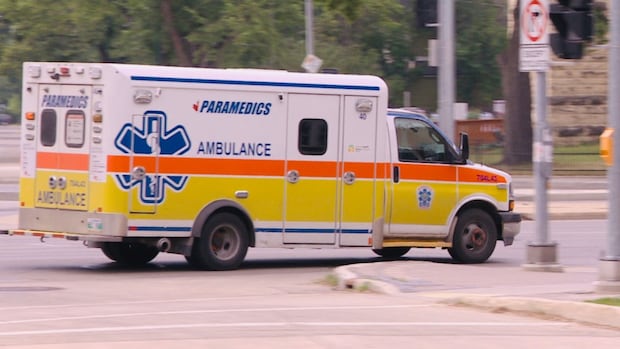ManitobaThe union representing firefighters says the City of Winnipeg is putting the public at risk through understaffing of emergency responders — with only nine of 19 ambulances operating on Saturday.Backstopping the ambulance shortfall means fire crews delayed in 911 calls, union saysDarren Bernhardt · CBC News · Posted: Aug 19, 2025 2:44 PM EDT | Last Updated: 11 hours agoJust nine of 19 ambulances were operating in Winnipeg on Saturday due to staff shortages, says Nick Kasper, president of the United Fire Fighters of Winnipeg. (Ron Dhaliwal/CBC)The union representing firefighters says the City of Winnipeg is putting the public at risk through understaffing of emergency responders — with only nine of 19 ambulances operating on Saturday.On top of that, only six of the 11 communications operator shifts — 911 call takers and dispatchers — were filled, said Nick Kasper, president of United Fire Fighters of Winnipeg.”We’re talking about only having nine ambulances for a city with over 800,000 people, on a Saturday night. You can do the math — the ambulance response times are significantly delayed,” he said.In an emailed statement to CBC News, Winnipeg Fire Paramedic Service Chief Christian Schmidt acknowledged the “significant number of unplanned absences” and said every effort was made to fill the shifts, but those were unsuccessful.”At any given time, some members will be on vacation, in accordance with WFPS policies and collective agreements. In addition to staff being away on their allotted vacation time, WFPS also receives sick time calls each shift and has members away on long-term leaves,” he wrote.The domino effect means the extra weight is carried by fire crews. As part of Winnipeg’s integrated model, each fire vehicle has a firefighter-paramedic on board.Winnipeg Fire Paramedic Service Chief Christian Schmidt says by the end of 2025, the city will have hired more than 50 new firefighters and 25 new paramedics. (Travis Golby/CBC)Backstopping the ambulance shortfall means fire crews attend more medical calls and wait until an ambulance arrives to transport a patient.”And while we’re doing so, we’re not available for 911 calls in our community, whether those are life-threatening medical emergencies or structure fires,” Kasper said.In an industry that measures success or failure in seconds — a fire can double in size every 30-60 seconds — that wait can be tragic, he said, giving the example of a response time of nine minutes and 40 seconds to a house fire in St. Vital on Aug. 10.”The structure was a total loss and both neighbouring homes were damaged,” Kasper said. “These are the devastating consequences.”The closest fire station was on Dakota Street, about a kilometre away, but there were no trucks available there, so crews had to be called in from stations farther away.The target response time for WFPS is four minutes, but it’s been closer to double that since 2021, Kasper said.This summer, there was a 10-minute response time to a house fire in Transcona, while it took nearly 14 minutes to get crews to a house fire in The Maples, he said.”I’ve never seen anything like that in my 18 years in the service,” Kasper said.In the latter incident, the closest available fire truck for a call in the city’s northwest corner was downtown.Within the past two months, there have been 15-minute responses to serious medical calls, Kasper said.”That’s contributing or resulting in loss of lives.”The issue is compounded by insufficient staffing, he said. Firefighters already work overtime to fill those vacancies and are now trying to carry the shortfall for the ambulances.Nick Kasper, president of the United Fire Fighters of Winnipeg, is concerned about the resources available to respond to emergency calls in Winnipeg. (Josh Crabb/CBC)Council has known since a 2009 audit that WFPS staffing is insufficient, Kasper said. There are fewer staff and fire trucks now than in 1975, when the city’s population was 570,000, he said.Consequently, UFFW members are experiencing severe burnout, Kasper said. That leads to more staff shortages as members go on leave, exacerbating the vicious cycle that causes physical and psychological injuries.”Starting our shifts 10, 20, 30 and even 40 firefighters short is not unusual,” he said. “Time lost due to psychological injury is our fastest-climbing statistic.”In 2024, the WFPS lost 17,600 hours to Workers Compensation Board claims for psychological ailments.”I’ve never, in my 18 years, seen morale this bad,” Kasper said.Last year, the city spent more than $10 million on firefighter overtime, which is enough to hire 70 full-time staff, Kasper said. For the first fiscal quarter of 2025, $6.5 million was spent on overtime.”This is not an efficient way to staff a public safety service. Winnipeggers are paying more and they’re receiving less,” he said. “But [council] seems happy to defend the status quo.”In his email, Schmidt said steps are being taken to address the issues.”By the end of 2025, we will have hired more than 50 new firefighters and 25 new paramedics. These new hires replace those lost through attrition, including retirements,” he said. In 2024, the province funded 40 new firefighters to coincide with the new WFPS station in Waverley West, he said.But recruitment is an ongoing challenge, as is the increasing volume of calls and risks of burnout, Schmidt said.”This is not an easy career. I want to thank all our members for their continued service to residents.”As for response times, they are constantly monitored and improvements have been made since the switch to a new priority dispatch system earlier this year, Schmidt said.”This new system aims to ensure those with the most time-dependent emergencies receive care first. Other less time-dependent calls may wait,” he said.ABOUT THE AUTHORDarren Bernhardt has been with CBC Manitoba since 2009 and specializes in offbeat and local history stories. He is the author of two bestselling books: The Lesser Known: A History of Oddities from the Heart of the Continent, and Prairie Oddities: Punkinhead, Peculiar Gravity and More Lesser Known Histories.With files from Dave Baxter
Sunday, 21 Dec 2025
Canada – The Illusion
Search
Have an existing account?
Sign In
© 2022 Foxiz News Network. Ruby Design Company. All Rights Reserved.
You May also Like
- More News:
- history
- Standing Bear Network
- John Gonzalez
- ᐊᔭᐦᑊ ayahp — It happened
- Creation
- Beneath the Water
- Olympic gold medal
- Jim Thorpe
- type O blood
- the bringer of life
- Raven
- Wás’agi
- NoiseCat
- 'Sugarcane'
- The rivers still sing
- ᑲᓂᐸᐏᐟ ᒪᐢᑿ
- ᐅᑳᐤ okâw — We remember
- ᐊᓂᓈᐯᐃᐧᐣ aninâpêwin — Truth
- This is what it means to be human.
- Nokoma











